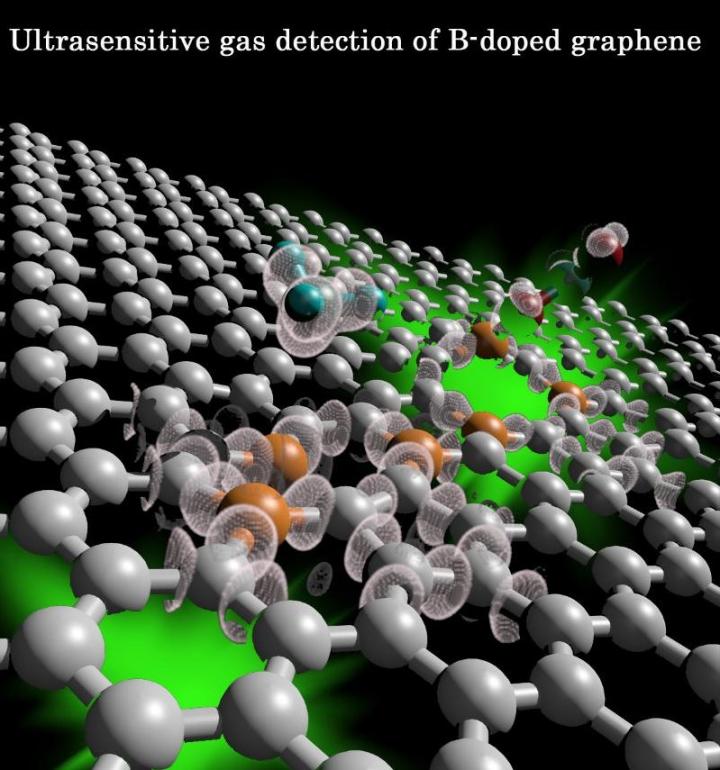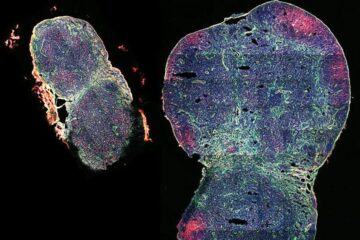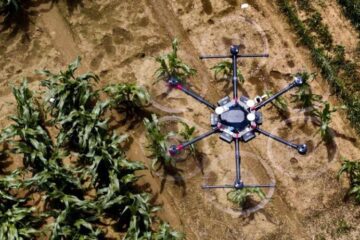Ultrasensitive sensors made from boron-doped graphene

This is a drawing of boron doped graphine. Credit: Torones, Penn State
Graphene is known for its remarkable strength and ability to transport electrons at high speed, but it is also a highly sensitive gas sensor. With the addition of boron atoms, the boron graphene sensors were able to detect noxious gas molecules at extremely low concentrations, parts per billion in the case of nitrogen oxides and parts per million for ammonia, the two gases tested to date.
This translates to a 27 times greater sensitivity to nitrogen oxides and 10,000 times greater sensitivity to ammonia compared to pristine graphene. The researchers believe these results, reported today (Nov. 2) in the Proceedings of the National Academy of Sciences, will open a path to high-performance sensors that can detect trace amounts of many other molecules.
“This is a project that we have been pursuing for the past four years, ” said Mauricio Terrones, professor of physics, chemistry and materials science at Penn State. “We were previously able to dope graphene with atoms of nitrogen, but boron proved to be much more difficult. Once we were able to synthesize what we believed to be boron graphene, we collaborated with experts in the United States and around the world to confirm our research and test the properties of our material.”
Both boron and nitrogen lie next to carbon on the periodic table, making their substitution feasible. But boron compounds are very air sensitive and decompose rapidly when exposed to the atmosphere. One-centimeter-square sheets were synthesized at Penn State in a one-of-a-kind bubbler-assisted chemical vapor deposition system. The result was large-area, high-quality boron-doped graphene sheets.
Once fabricated, the researchers sent boron graphene samples to researchers at the Honda Research Institute USA Inc., Columbus, Ohio, who tested the samples against their own highly sensitive gas sensors. Konstantin Novoselov's lab at the University of Manchester, UK, studied the transport mechanism of the sensors. Novoselov was the 2010 Nobel laureate in physics.
Theory collaborators in the U.S. and Belgium matched the scanning tunneling microscopy images to experimental images, confirmed the presence of the boron atoms in the graphene lattice and their effect when interacting with ammonia or nitrogen oxide molecules. Collaborators in Japan and China also contributed to the research.
“This multidisciplinary research paves a new avenue for further exploration of ultrasensitive gas sensors,” said Avetik Harutyunyan, chief scientist and project leader at Honda Research Institute USA Inc. “Our approach combines novel nanomaterials with continuous ultraviolet light radiation in the sensor design that have been developed in our laboratory by lead researcher Dr. Gugang Chen in the last five years. We believe that further development of this technology may break the parts per quadrillion level of detection limit, which is up to six orders of magnitude better sensitivity than current state-of-the-art sensors.”
These sensors can be used for labs and industries that use ammonia, a highly corrosive health hazard, or to detect nitrogen oxides, a dangerous atmospheric pollutant emitted from automobile tailpipes. In addition to detecting toxic or flammable gases, theoretical work indicates that boron-doped graphene could lead to improved lithium-ion batteries and field-effect transistors, the authors report.
###
The lead authors of the PNAS paper are Ruitao Lv, a former Penn State postdoctoral scholar in physics now at Tsinghua University, Beijing; Gugang Chen; Andrés Botello-Méndez, Catholic University of Louvain la-Neuve; and Amber McCreary, a graduate student in physics.
The National Natural Science Foundation of China; Multidisciplinary University Research awards from the U.S. Air Force Office of Scientific Research; Honda Research Institute USA Inc.; Europe's Graphene Flagship; Penn State's Center for Nanoscale Science, a National Science Foundation MRSEC, and Penn State's Materials Research Institute funded this work.
Media Contact
All latest news from the category: Materials Sciences
Materials management deals with the research, development, manufacturing and processing of raw and industrial materials. Key aspects here are biological and medical issues, which play an increasingly important role in this field.
innovations-report offers in-depth articles related to the development and application of materials and the structure and properties of new materials.
Newest articles

Expanding a lymph node, boosting a vaccine
A biomaterial vaccine enhances and sustains lymph node expansion following vaccination, boosting anti-tumor immunity in an animal model. Each one of us has around 600 lymph nodes (LNs) – small,…

AI to Make Crop Production More Sustainable
Drones monitoring fields for weeds and robots targeting and treating crop diseases may sound like science fiction but is actually happening already, at least on some experimental farms. Researchers from…

Cruise Ship as Data Collector
New Approaches in Ocean Observation… Scientific research – not only confined to dedicated research vessels but also from non-scientific vessels and marine infrastructures. This is one of the ideas promoted…





















